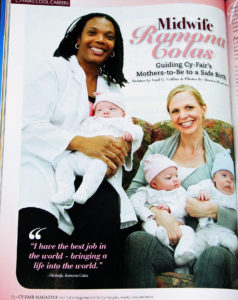 When people think of midwifery, antiquated notions of a granny in homespun might come to mind. The journey an infant takes to be born hasn’t changed since before cloth was woven on a loom, yet the ways a midwife attends to births today are both older than homespun and as updated as modern technology. As a practicing midwife, Ramona Colas assists Cy-Fair mothers-to-be as they eagerly await their new bundles of joy.
When people think of midwifery, antiquated notions of a granny in homespun might come to mind. The journey an infant takes to be born hasn’t changed since before cloth was woven on a loom, yet the ways a midwife attends to births today are both older than homespun and as updated as modern technology. As a practicing midwife, Ramona Colas assists Cy-Fair mothers-to-be as they eagerly await their new bundles of joy.
Following Grandmother’s Footsteps
Colas is a certified nurse midwife who comes from a lineage of midwives. “Long story short, my grandmother was a midwife in Mississippi, by default,” Colas says. “African American women weren’t allowed to deliver in hospitals, so she helped them birth their babies.”
Growing up, Colas heard stories at her grandmother’s knee and gained an appreciation for the process. She wanted to be like her. “I saw birth as a miracle,” she says. Though Colas got sidetracked, falling into an opportunity as a flight attendant for nearly two decades, she always had a passion for helping others through the birthing process. Feeling called toward the profession, she decided to go back to school.
After finishing nursing school in New York, Colas earned a master’s degree at the University of Texas Medical Branch at Galveston in 2000. She practiced there for several years before joining Dr. Tamyra Comeaux at Northwest Obstetrics and Gynecology.
The word midwife is an Anglo-Saxon term meaning ‘with women,’ shares Colas, and she spends a lot of time educating women about their well-being. “I nurture women through all phases of their life, and that includes birth – I specialize in birth,” she says.
Myths About Midwifery
Many people mistakenly assume that midwives deliver babies only in homes and have no formal education. In fact, their training can take a variety of routes, and most midwives deliver in hospitals. A midwife does not have the same education as an obstetrician, but she is still a highly trained professional. A popular phrase in the birthing community is, “An obstetrician delivers a baby, and a midwife attends a birth.” The idea is that birthing is an instinct, and midwives guide babies into the world. In practice, both have their places.
Beyond the lay midwife who apprentices to gain experience, there are two formally trained types of midwives. Direct-entry midwives receive certifications or licenses through various school settings and do not have a nursing degree. A certified nurse midwife (CNM), as the name indicates, has a college background with advanced education. CNMs account for the largest percentage of practicing midwives today. And in the U.S., where birth has become a medically centered experience with a cesarean delivery rate over 30%, CNMs enjoy a versatile career with the ability to practice in diverse settings. Regardless of their training, the safety of mother and baby is every midwife’s top priority from conception to birth.
As a CNM, Colas has brought babies forth at home and in a hospital, but her recent job shift to the Cy-Fair area in 2008 has somewhat limited her. It’s not her skills, but regulations that determine what Colas can do now. “Cy-Fair Hospital’s bylaws allow me to admit patients, monitor their progress, administer medication – everything except physically deliver the child,” she says. And it’s not just rules that restrain a midwife’s ability to assist mothers.
“Home birth liability insurance is driving midwives out of the homebirth business,” Colas says. She believes the problem might create a gap in care over time, as some obstetricians may also be getting out of the baby business because of liability.
In the future, she predicts that there will be fewer choices for pregnant women. “There used to be three midwifery programs in Texas, but there are no more left,” Colas says.
A Natural Process
A mother’s instincts kick into high gear when she becomes pregnant. Colas understands this and honors those instincts. She uses many natural remedies, including herbs and supplements, for a holistic approach, employing a less-is-more method, except when it comes to nutrition. The quality of meals is important to guard against obesity, medical complications, and provide vitality for both mother and baby.
In amazing response to pregnancy, every bodily system changes, including blood and circulation, which expands to work for two. A mother recognizes that connection with baby’s first kick. It’s one she will never lose, even when the umbilical cord is cut. The remarkable bond mirrors Aristotle’s response to the
question, “What is a friend?” He answered, “One soul inhabiting two bodies.” This guides a midwife’s desire to teach mothers about their bodies. “Knowledge is power and sharing the understanding of their bodies empowers women,” Colas says. “They become unafraid.”
The Miracle of Life
Despite formal education and technical advances, midwifery is still a calling. At the heart of it, pregnancy and the ensuing birth begets a mutual exchange of trust and confidence. A midwife serves not only the mother, but also her family in her time-honored profession and duty. “I have the best job in the world – bringing a life into the world,” says Colas. “A baby always has that wow factor.” CFM
About Midwives
- Certified nurse midwives (CNMs) can administer medication, like an epidural.
- The majority of midwives attend births in hospitals (not homes).
- Midwives in Europe attend up to 75% of births, as opposed to 5% in the U.S.
- Most women who have given birth report experiencing less pain when assisted by a midwife.
- Midwives honor traditional methods, while practicing conventional medicine. *Source: Midwifery Today Magazine
HOW TO FIND A MIDWIFE
Visit midwife.org for an online practice locator and more info about CNMs, or ask your hospital for a list of midwives who practice there.

